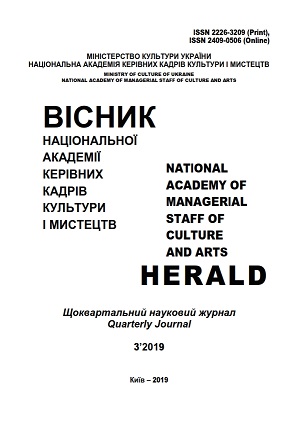Трактат «Правила гармонічні й мелодичні…» В. Манфредіні у
перекладі С. Дегтярьова в парадигмі сучасної теорії поліфонії
V. Manfredini’s Treatise “The Harmonic and Melodic Rules” in S. Degtyaryov’s Translation in the Paradigm of the Modern Theory of Polyphony
Author(s): Nataliya Mykolayivna BelichenkoSubject(s): Cultural history, Music, 18th Century, 19th Century, Translation Studies, History of Art
Published by: Національна академія керівних кадрів культури і мистецтв
Keywords: S. Degtyaryov as translator; treatise Harmonic and Melodic Rules by V. Manfredini; polyphonic thinking; the theory of polyphony; counterpoint; fugue;
Summary/Abstract: Purpose of the article. A place in the paradigm of the modern theory of polyphony of the treatise «Regole armoniche, o sieno precetti ragionevoli per apprendere la musica» by V. Manfredini («Harmonic rules, or reasonable precepts for learning of music», 1797, Venice) is considered in the creative translation of an outstanding Ukrainian composer Degtyaryov («Harmonic and Melodic Rules for learning of all music», 1805, St. Petersburg). The methodology of the work combines historical, cultural, system-structural and theoretical approaches, which revealed the key role of the considered translation work of S. Degtyaryov, firstly, in getting out of the crisis situation that had matured by that time in the domestic musical pedagogy, secondly, in the next - after a «Musical Grammar» by M. Diletsky - process of gradual Europeanization of theoretical music education and, more broadly, the secularization of musical art in Ukraine and Russia in accordance with the general socio-cultural realities. Scientific novelty consists in drawing special attention to the work of V. Manfredini, translated by S. Degtyarev, as a starting point for the modern Russian theory of music and, in particular, the theory of polyphony. Conclusions. It is established that the appearance at the turn of the XVIII-XIX centuries the S. Degtyaryov's translation work provided favorable conditions for the transmission of a new - Western European - cultural paradigm in music, for several decades later filling in the existing significant gap in the then musical theoretical literature. It is revealed that the role of the translation work creatively carried out by S. Degtyaryov in this process can be characterized as a conscious translation on the national basis of the European musical-theoretical vocabulary of the New Age, in particular, of counterpoint and fugue, in the form of a systematic set of basic rules.
Journal: Вісник Національної академії керівних кадрів культури і мистецтв
- Issue Year: 2019
- Issue No: 3
- Page Range: 189-195
- Page Count: 7
- Language: Ukrainian

